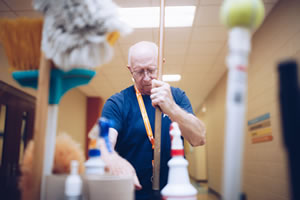5 Keys to Proactive Locker Room Cleaning
- By Gordon Buntrock
- 09/01/19
 Smart cleaning isn’t just about removing soils; it’s
about controlling the sources. Entryway mats are a great example.
When it comes to locker rooms, a proactive approach
controls and contains, so spaces across the school don’t suffer by
association. Here’s a few proactive locker room cleaning tips:
Smart cleaning isn’t just about removing soils; it’s
about controlling the sources. Entryway mats are a great example.
When it comes to locker rooms, a proactive approach
controls and contains, so spaces across the school don’t suffer by
association. Here’s a few proactive locker room cleaning tips:
From Clean to Dirty
It’s tempting to tackle the big stuff first,
but locker rooms should be cleaned in a specific order, starting
with the least dirty to the most. Organize the order of cleaning to
ensure progression never crosses over previously cleaned areas.
And just like home, clean high before low — an efficient process
never re-soils cleaned surfaces. Since every locker room is different,
special attention must be taken to adjust best practice to the
shape of the space.
Flex on Those Microbes
Quality locker room cleaning for
schools should use EPA-registered, hospital-grade disinfectants
to clean all touch points and floors. Look for EPA-registered disinfectants that leave less residue while still providing the
superior cleaning you need for grouted tile and other surfaces.
Consider electrostatic disinfection to drastically improve sanitation
of crevices and other locker room locations that are hard to
reach with other tools.
Address Those Smells
Protein-based soils can build up
around floor drains, or on other surfaces, contributing to
that infamous mashup of smells locker rooms are famous for.
Supplement your cleaning cycle with periodic application of
enzyme-based chemicals to break down those proteins before
they can build up persistent odors.
Test Your Water
If the water used in your locker room is “hard
water” that will make some cleaning solutions inappropriate.
Higher concentrations of calcium, iron and magnesium can
require different solutions to achieve deep cleaning efficiently.
Keep Up with Your Students
Locker rooms are high-traffic
areas. If cleaning doesn’t rise to the frequency of use, that unfairly
impacts students using the locker room late in the cleaning
cycle. It also increases the amount of soil and particle spread
from the locker room to other school spaces. Efficiency in locker
room cleaning can instead come from careful attention to the
schedule and rigorous training.
This article originally appeared in the School Planning & Management September 2019 issue of Spaces4Learning.
About the Author
Gordon Buntrock is the national director of service delivery for education services at ABM. Prior to joining ABM, he was a director of operations for environmental services at Aramark Healthcare. He can be reached at [email protected].